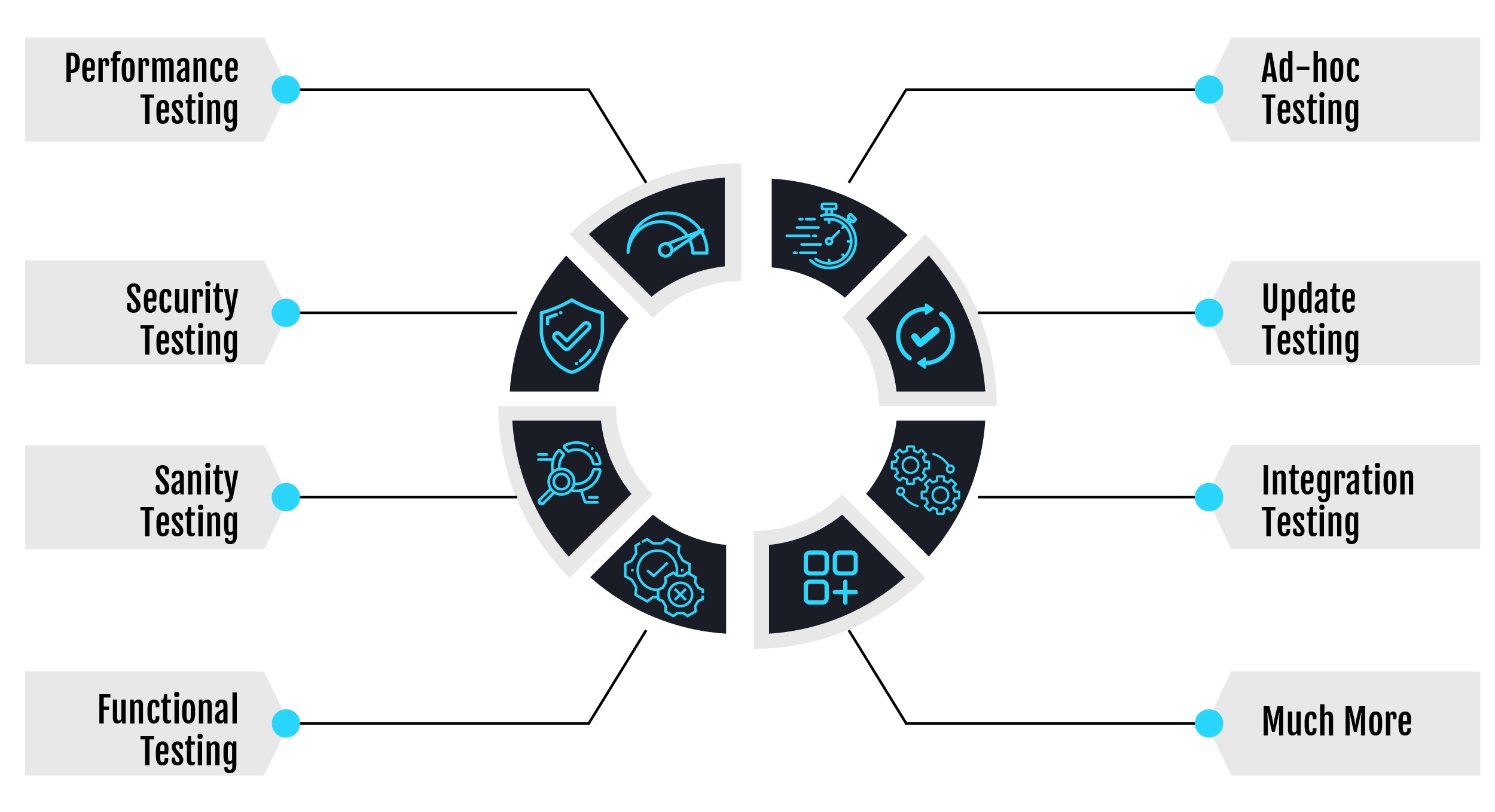Introduction
The users of business software are aware that testing is necessary, in 2023, this question turns into ‘to automate or not to automate.’ The vast majority of individuals think that test automation is an excellent resource for saving time and money on testing. Automation Testing is a software testing method that uses specialized automated testing software tools. It focuses on automating tests, storing test data, and leveraging test results to improve software product quality. This quality assurance approach seeks to replace human interaction with technologies and equipment.
A published survey report on automation states that only 5% of businesses utilize automated testing fully. Regarding plans for the future, as many as 73% of businesses hope to achieve a 50:50 or 25:75 ratio for “manual to automation.” Merely 14% expressed their desire to do away with manual testing completely. So, what does it explain? Most businesses are not happy with their testing program.
Why is the automation of testing taking longer to catch on than it does in other industries, such as manufacturing, copywriting, and retail? Currently, cloud storage accounts for 60% of all company data. A standard company makes use of 1,295 cloud services. That is a significant amount of updates, migrations, and ERPs—in other words, a significant amount of testing that might be automated but is still done by hand. The cause of this – Myths and misconceptions.
Myths and misconceptions have been lying around test automation, haunting organizations not to give it a try. These myths and misconceptions regarding automated testing processes, costs, and requirements frequently prevent clients from making the modifications necessary to remain competitive and up to date with their packaged software. In this blog, we are going to discuss the top 7 myths about automation testing, the difference between manual and automation testing and what are the challenges.
What is the Key Difference between Manual testing and Automation testing?
In automated testing, pre-defined tests are written and run programmatically by computer programs, applications, or scripts. In manual testing, human testers interact with a software application or product to find problems. Let’s look at the Key differences between manual and automation testing:
| Testing Parameters | Manual Testing | Automation Testing |
|
Definition |
A human tester runs the test cases during manual testing.
|
The software tools in automated testing run the test scenarios.
|
|
Speed |
Manual testing takes a lot of time. |
Compared to manual testing, automation testing is quicker.
|
|
Resource Requirements |
Workforce resources are required for manual testing.
|
Automation testing requires both skilled workers and automation tools.
|
|
Frameworks |
Frameworks are not used in manual testing.
|
Data Drive, Keyword, and other frameworks are used in automation testing.
|
|
Reliability |
Human errors can occur, which makes manual testing unreliable.
|
The utilization of automated tools and scripts makes automated testing more trustworthy.
|
|
Test Reports |
The test results from manual testing are kept on file in an Excel spreadsheet, making them difficult to access.
|
All stakeholders in automated testing have easy access to the test findings through the automated tool’s interface. |
|
Programming Skills |
Manual testing doesn’t need any programming skills.
|
Automation testing involves programming skills because the use of tools needs skilled employees.
|
7 Common Myths about Automation Testing
For numerous teams seeking to enhance testing efficiency and shorten the testing life cycle, automated testing has proven to be the ideal option. However, many common myths regarding automation testing keep individuals from reaping its full benefits.
Myth: 1 – Compared to manual testing, automation is costlier
Automation testing can result in long-term cost reductions if properly planned and implemented. Test automation can save time that would otherwise be spent on manual testing, so while the initial investment in automated testing tools and hiring testers can seem daunting, the ROI is frequently significant.
Automated tests not only save manual testers a great deal of time that would be better used developing the product, but they also shorten the time it takes to develop the product and find issues early on, which lowers development expenses.
Due to these factors, automated testing is more affordable than manual testing.
Myth: 2 – Manual testing is replaced by automated testing
It’s a common misconception that automated testing takes the place of manual testing. This is untrue. There are specific use cases for each of these two methods, which should be used in tandem with one another. Testers can utilize this time to investigate software using risk-based, exploratory, and other testing methodologies, and assist developers throughout the process, while the automated tests automate repetitive chores multiple times a day. Manual testing is still vital since it helps uncover new weaknesses in the application that would otherwise be difficult to detect with automated testing.
Manual testing is also a humanized technique that emphasizes user empathy and the use of the application in the same way that a customer would. This cannot be automated.
Myth: 3 – All testing issues will be resolved by automation
Not everything can be solved by automation. When human observation, upkeep, and collaboration are lacking, automation engineers will always encounter inaccurate results and flaky builds.
New issues can also arise because of automation testing. One issue with automated testing methods, for instance, is coding for more complex scenarios that are simpler to test manually, such as pop-up windows, numerous tabs, and dynamic content.
Testers with particular knowledge and abilities will still be needed for automation testing to manage tools, build scripts, debug issues, and maintain test cases.
Myth: 4 – Automated Testing Is Only Possible by Skilled Professionals
Usually, test scripts are written by developers, engineers, and architects. For this reason, a lot of people think that having a lot of coding experience and knowledge is necessary before using automated testing.
These days, though, a lot of software solutions allow the average person to automate everyday operations without the need for any special knowledge.
Myth: 5 – Only big projects with lots of resources are good candidates for Automation testing
Automating tests applies to all software and digital environments. Every project can benefit from automation, but smaller projects with constrained resources and condensed timelines can benefit most from it. The benefits of automated testing are enormous.
Myth: 6 – Automation Testing is limited to regression testing
Regression testing is not the only use for test automation. Automation needs to be taken into account for testing frameworks like performance, functional, ad hoc, security, integration, and update. This will save money while ensuring optimal coverage, code reuse, and increased efficiency.

Myth: 7 – Automation Ensures Success
There’s a myth that technology and automation will always produce precise outcomes and bring success. But automated software is only one part of the process of automation as a whole. It still requires specific knowledge to write scripts, do troubleshooting, and run efficiently. Additionally, the program is still susceptible to malfunctions, false positives, and unexpected failures in identifying problems.
Something that has flaws of its own cannot ensure QA success on its own. On the other hand, when combined with other related practices, it can boost the chances of success and offer a more complete view of the application being tested.
What are the major challenges faced in automation testing?
Nowadays, having a strong test automation system is essential for developing software. In the ideal scenario, the system would run tests on several devices simultaneously, speeding up the results. Additionally, it gives engineers more time to create new test cases, create tools for more thorough testing, and participate more actively in code reviews. They can create new scripts and code rather than repeating the same test fifteen times. Let’s discuss the challenges in automation testing-
1. Choosing the appropriate framework and equipment
One of the most important challenges in automation testing is selecting the appropriate automation tool to ensure automation success. It’s hard to decide because there are so many tools accessible, both licensed and open-source. The type of application and level of automation testing determine which tool is best.
2. Teamwork and effective communication within the team
One of the main issues with automation testing is a lack of teamwork and communication. Automation testing is highly dependent on efficient communication between all stakeholders because it requires significant investments and provides long-term ROI (Return On Investment) rather than rapid gratification.
3. Establishing reasonable expectations for automation
Test automation has received a lot of attention. Sadly, organizations think automation can magically cure all their problems, which is untrue.
Higher management should be made fully aware of the reasonable expectations about test automation. A thorough documentation of the things and amounts that should be automated to maximize benefits is also necessary.
4. Significant upfront expenses
A significant upfront investment is required for automation in terms of infrastructure, tools, and skilled labor. On top of operating expenses, there can be a license fee.
The cost of production errors compared to the setup costs of automation should be calculated to demonstrate to management the significant financial benefits of automation.
5. Obtaining the right talents
Coding and dilemma-solving abilities are needed for anything from creating test automation frameworks to developing test scripts. The majority of test automation tools are only truly useful when they are used by people with the ability to create and manage automation frameworks, develop solutions, and write correct test scripts. They also need to be capable of handling unforeseen technical issues.
Today’s consumers are getting a “phygital” experience thanks to digital technology, which is bridging the gap between the physical and digital worlds. Quality engineering is now a crucial component of any company’s digital strategy to stay flexible and provide excellent customer service.
At eInfochips (an Arrow company), our extensive engineering experience, business value-focused testing and automation methodology, ongoing focus on next-generation QA technologies, field-proven accelerators and frameworks, and reusable QA assets enable clients across industries to achieve high product and software quality. Contact our experts today to learn more about our key offerings and services.
Bottomline
Test automation is becoming more and more popular, despite a lot of misconceptions about it. Myths around automated tests continue to surface, indicating that much work needs to be done to dispel confusion. Test automation is a step toward simplifying, not complicating. The choice to automate tests encourages simplicity over complexity. It is a technological advancement that secures ERP (Enterprise Resource Planning) in an unstable market, saves time, and enables enterprises to focus on higher-value duties.













